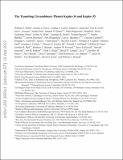The transiting circumbinary planets Kepler-34 b and Kepler-35 b
Author(s)
Winn, Joshua Nathan
DownloadWinn_The transiting.pdf (8.466Mb)
PUBLISHER_POLICY
Publisher Policy
Article is made available in accordance with the publisher's policy and may be subject to US copyright law. Please refer to the publisher's site for terms of use.
Alternative title
Transiting circumbinary planets Kepler-34 b and Kepler-35 b
Terms of use
Metadata
Show full item recordAbstract
Most Sun-like stars in the Galaxy reside in gravitationally bound pairs of stars (binaries). Although long anticipated the existence of a ‘circumbinary planet’ orbiting such a pair of normal stars was not definitively established until the discovery9 of the planet transiting (that is, passing in front of) Kepler-16. Questions remained, however, about the prevalence of circumbinary planets and their range of orbital and physical properties. Here we report two additional transiting circumbinary planets: Kepler-34 (AB)b and Kepler-35 (AB)b, referred to here as Kepler-34 b and Kepler-35 b, respectively. Each is a low-density gas-giant planet on an orbit closely aligned with that of its parent stars. Kepler-34 b orbits two Sun-like stars every 289 days, whereas Kepler-35 b orbits a pair of smaller stars (89% and 81% of the Sun’s mass) every 131 days. The planets experience large multi-periodic variations in incident stellar radiation arising from the orbital motion of the stars. The observed rate of circumbinary planets in our sample implies that more than ~1% of close binary stars have giant planets in nearly coplanar orbits, yielding a Galactic population of at least several million.
Date issued
2012-01Department
Massachusetts Institute of Technology. Department of PhysicsJournal
Nature
Publisher
Nature Publishing Group
Citation
Welsh, William F. et al. “Transiting Circumbinary Planets Kepler-34 b and Kepler-35 b.” Nature 481.7382 (2012): 475–479.
Version: Author's final manuscript
ISSN
0028-0836
1476-4687